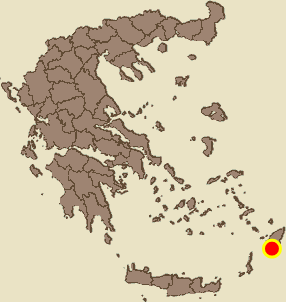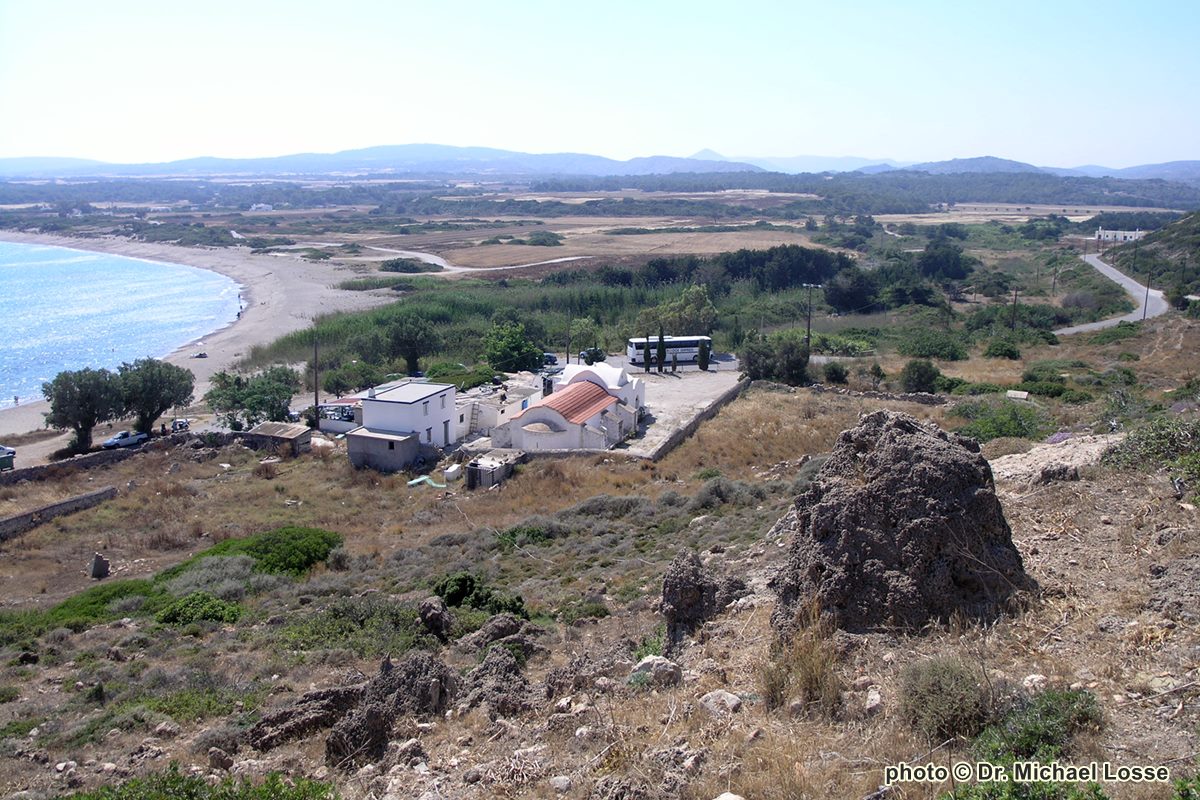Πλιμμυρι, Rhodes, Dodecanese,South Aegean
Watchtower of Plimmyri
| Location: |
| At the northern side of the beach of Plimmyri in south Rhodes, above the church of Zoodochos Pigi |
| Region > Prefecture: |  |
| South Aegean Dodecanese | |
| Municipality > Town: | |
| City of Rhodes • Πλιμμυρι | |
| Altitude: | |
| Elevation ≈ 38 m |
| Time of Construction | Origin | |
| end of 15th cent. | IOANNITE |
|
| Castle Type | Condition | |
| Watchtower |
Few Remains
|
Foundations of a late-medieval watchtower of the Knights Hospitallers, part of the “chain” of coastal watchtowers protecting the island of Rhodes.
Tower Description
Text: Dr. Michael Losse – Singen (Hohentwiel), Germany (13.07.2021)
General Description
In the south of the island, on the east coast, lies the hamlet of Plimmýri at the northern end of the bay of the same name. The bay’s southwest end closes the Jermatá peninsula called Cape Víglas, occupied by a Knights Hospitallers‘ watchtower, while in the northeast it is bordered by a higher peninsula rising behind the hamlet, on which a watchtower stood (cf. Losse 2009, p. 255).
There are lines of sight from the presumed tower location to the watchtower on Cape Víglas (or Cape Jermatás) in southwestern direction, to the presumed location of the watchtower of Mávros Kávos further in southwestern direction and to the Piliókastro near Kattaviá in the northwest.
Access
The hamlet of Plimmýri can be reached via a road about 2 km long. This branches off at Chóchlakas from the road leading to Kattavía. The location of the tower is behind the Zoodóchos Pigí monastery and the taverna. Free access.
History of the tower
The tower was built during the Knights of St. John‘s (Hospitaller Knights‘) rule in the 15th century.
It rose on the edge of a region already inhabited in antiquity, as the German traveller, artist and researcher Albert Berg (1862, p. 259) reported: “North of the monastery, surrounded by cliffs, a rocky hill jumps into the sea; close to it, a half-destroyed stone dam forms a small harbor, which is now almost completely silted up. At the top of the hill, overgrown by dense symours, there are still the indigestible ruins of old buildings, just as in the plain that extends south to Cape Vigli [cf. Kastrologos: Watchtower on Cape Jermata]. There is no doubt that a village stood here in ancient times. On the English map, the place is called Istros; Professor Ross and Mr. Guérin believed to have found here the location of the old Hia, which Strabo cites as initially following Lindos”
(German original text: “Nördlich vom Kloster springt, von Klippen umgeben, ein Felsenhügel in’s Meer; dicht dabei bildet ein halb zerstörter Steindamm einen kleinen Hafen, welcher jetzt fast ganz versandet ist. Auf dem Gipfel des Hügels finden sich noch, von dichtem Gesträuche überwuchert, die unförmlichen Trümmer alter Gebäude, eben so in der Ebene, welche sich südlich nach Cap Vigli [Jermata (Kattavía): Wachtturm (auf dem Kap Víglas)] hinzieht. Dass hier in antiker Zeit eine Ortschaft gestanden hat, ist unzweifelhaft. Auf der englischen Karte heisst die Stelle Istros; Professor Ross und Herr Guérin glaubten hier die Lage des alten Hia gefunden zu haben, welches Strabo als auf Lindos zunächst folgend anführt.”)
During the time of the Italian occupation of the Dodecanese, fortifications were built on the plateau above the port of Plimmýri, partly with the removal of previously standing buildings. The tower itself was built over by fortifications of the 2nd World War.
Other Info
SourcesLosse, Michael: Wacht- und Wohntürme aus der Zeit des Johanniter-Ordens (1307-1522) auf der Ägäis-Insel Rhódos (Griechenland). In: Burgen und Schlösser 4, 2009, pp. 245-261.
Losse, Michael: Die Burgen und Festungen des Johanniter-Ritterordens auf Rhódos und in der Ägäis (Griechenland) 1307-1522. (Publisher: Nünnerich-Asmus Verlag) Mainz 2017.
Losse, Michael: Die (Küsten-)Wachttürme des Johanniter-Ritterordens auf der Insel Rhódos (Dodekanes, Griechenland) bis 1522 – Zum aktuellen Forschungsstand. In: fortifikation. Fachblatt des Studienkreises für Internationales Festungs-, Militär- und Schutzbauwesen e.V. (INTERFEST), Vol. 34, 2020, pp. 59-90.
| First entry in Kastrologos: | July 2021 |
Sources
- Photos (June 2007) and article by Dr. Michael Losse
|
|
| Access |
|---|
| Approach to the monument: |
| Plimmýri can be reached via a road about 2 km long. This branches off at Chóchlakas from the road leading to Kattavía. The location of the tower is behind the Zoodóchos Pigí monastery and the taverna. |
| Entrance: |
| Free access |




